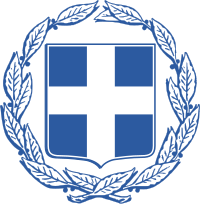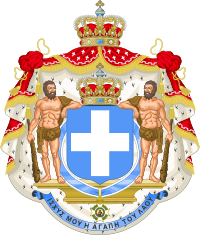| Coat of arms of Greece |
|---|
 Monochrome version, as used by the government |
|
 Non-monochrome version |
|
|
|---|
| Armiger | Greece |
|---|
| Adopted | 1975 |
|---|
| Shield | Azure, a cross throughout Argent |
|---|
| Other elements | The escutcheon is wholly surrounded by two laurel leaves. |
|---|
The coat of arms of Greece displays a white cross on a blue escutcheon, which is surrounded by two laurel branches.
The Greek government normally uses a blue, monochrome rendering of the arms. The laurel leaves are golden in the version used by the military, and as it appears on the personal standard of the President.
History
During the reign of the Bavarian King Otto, the first Greek royal coat of arms was introduced, with two crowned lion supporters holding the shield with the royal crown. Upon the arrival of King George I, the coat of arms was replaced by the Danish-inspired version. After Greece became a republic in 1924 the external ornamentation was abandoned. A new achievement was introduced with the restoration of the monarchy in 1935 and wes used until 1973, when the then-ruling military junta abolished the monarchy. 7 June 1975, the current arms was introduced. This is a restoration of the traditional arms, save any external ornamentation except laurel leaves. The government uses a stylised design by the artist Kostas Grammatopoulos.
Wittelsbach dynasty
The coat of arms of the Kingdom of Greece was the official symbol of the Greek state during the period of the monarchy (1832–1924 and 1935–1973).
The coat of arms was based on that of the Kingdom of Bavaria, and consisted of a shield bearing the Greek national emblem of a white cross on a blue background, topped by a royal crown and supported by two crowned lions rampant. At the centre of the cross lay an escutcheon bearing the characteristic lozenge pattern of Bavaria, as a symbol of the House of Wittelsbach.
This emblem was used during the reign of King Otto I, from 1832 to his exile in 1862.
Glücksburg dynasty
After Otto's fall, the young Prince William of Denmark was chosen as king, and the new coat of arms bears a strong resemblance to that of the Danish Royal Family. The central feature of the coat of arms remained a shield bearing the Greek national emblem of a white cross on a blue background. At the centre of the cross lies a shield with the dynastic arms of the Schleswig-Holstein-Sonderburg-Glücksburg family. The shield is topped with a crown and supported by two male figures, depicting the legendary Heracles.[1] The ribbon and medal of the Order of the Redeemer are suspended from the shield. The banner at the bottom bears the dynasty's motto, Ἰσχύς μου ἡ ἀγάπη τοῦ λαοῦ ("People's love, my strength").
This emblem appeared on coins of the Kingdom, and official documents from at least 1880 until 1973, except for the period of the Second Hellenic Republic (1924–1935), and continues to be used by the former Greek Royal Family.
List
| Coat of Arms
|
Date
|
Description
|

|
1833–1862
|
The coat of arms of the Kingdom of Greece during the Wittelsbach dynasty.
|

|
1863–1924
|
The coat of arms under the Glücksburg dynasty, created in 1863, used in the kingdom until 1924, when King George II was exiled.
|

|
1863–1973
|
Also created in 1863, used as a simplified version of the main royal coat of arms. Features the light blue cross couped of Greece, without the arms of the Glücksburg dynasty.
|

|
1936–1973
|
Created in 1936, after the restoration of the monarchy, in use until 1967, when King Constantine II was exiled, and then nominally until 1973 when the kingdom was replaced by the Hellenic "Republic". The arms remains in use by the former Greek Royal Family.
|

|
1924–1935
|
The coat of arms of the Second Hellenic Republic. Heraldically, this is identical to the current arms.
|
Historical, non-heraldic emblems
The first Greek national emblem was provided for by the Constitution of Epidauros of 1 January 1822 and was established by decree on 15 March of the same year. It was the shape of a blue and white circular cockade.
Since it was first established the emblem has undergone many changes in shape and in design, mainly due to changes of regime. The original Greek national emblem depicted the goddess Athena and the owl. At the time of Ioannis Kapodistrias, the first Prime Minister of modern Greece, the phoenix, the symbol of rebirth, was added.










